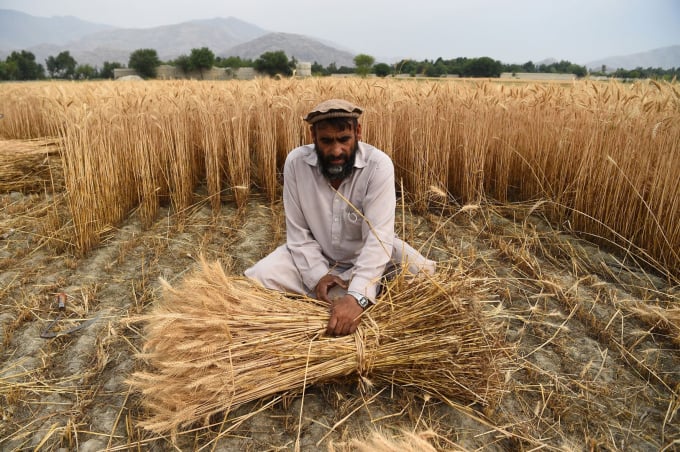June 14, 2025 | 07:27 GMT +7
June 14, 2025 | 07:27 GMT +7
Hotline: 0913.378.918
June 14, 2025 | 07:27 GMT +7
Hotline: 0913.378.918

A wheat farmer in Afghanistan.
World food commodity prices declined modestly in May for the second consecutive month, although wheat and poultry prices pushed higher, the Food and Agriculture Organization of the United Nations (FAO) reported today.
The FAO Food Price Index averaged 157.4 points in May 2022, down 0.6 percent from April. The Index, which tracks monthly changes in the international prices of a basket of commonly-traded food commodities, however, remained 22.8 percent higher than in May 2021.
The FAO Cereal Price Index increased by 2.2 percent from the previous month, led by wheat prices, which were up 5.6 percent from April and 56.2 percent from their corresponding value a year earlier. International wheat prices, averaging only 11 percent below the record high reached in March 2008, rose in response to an export ban announced by India and concerns over crop conditions in several leading exporting countries as well as reduced production prospects in Ukraine due to the war. International rice prices also rose across the board, while coarse grain prices declined by 2.1 percent, with maize prices dropping by even more in step with slightly improved crop conditions in the United States of America, seasonal supplies in Argentina and the imminent start of Brazil’s main maize harvest.
The FAO Vegetable Oil Price Index declined by 3.5 percent from April, while still markedly higher than its year-earlier level. Prices dropped for palm, sunflower, soy and rapeseed oils, due in part to the removal of Indonesia’s short-lived export ban on palm oil and sluggish global import demand for soy and rapeseed oils in view of elevated costs in recent months.
“Export restrictions create market uncertainty and can result in price spikes and increased price volatility, the decrease in oilseeds prices shows how important it is when they are removed and let exports flow smoothly,” said FAO Chief Economist Máximo Torero Cullen.
The FAO Dairy Price Index also dropped by 3.5 percent month-on-month. Prices of milk powders declined the most, linked to market uncertainties from the continued COVID-19 lockdowns in China, while robust retail sales and high demand from restaurants in the Northern Hemisphere prevented cheese prices from falling significantly despite weakened global import demand. Butter prices also dropped on account of a weaker import demand amid improved exportable supplies.
The FAO Sugar Price Index declined by 1.1 percent from April, as a bumper crop in India buoyed global availability prospects. The weakening of the Brazilian real against the U.S. dollar, along with lower ethanol prices, also pressured world sugar prices downwards.
Meanwhile, the FAO Meat Price Index set a new all-time high, increasing by 0.6 percent in May even as world bovine meat prices remained stable and those of pig meat fell. The climb was driven by a steep increase in international poultry meat prices, reflecting continued supply chain disruptions in Ukraine and recent cases of avian influenza amid a surge in demand in Europe and the Middle East.
Further details are available here.
Global cereal output and consumption on course to decline
Early prospects for global cereal production in 2022 now point to a likely decrease, the first in four years, to 2 784 million tonnes, down 16 million tonnes from the record output estimated for 2021, according to FAO’s latest Cereal Supply and Demand Brief, also released today.
The largest decline is foreseen for maize, followed by wheat and rice, while barley and sorghum outputs will likely increase. The forecasts are based on conditions of crops already in the ground and planting intentions for those yet to be sown.
World cereal utilization is also forecast to decline marginally in 2022/23, by around 0.1 percent from 2021/22 to 2 788 million tonnes, marking the first contraction in 20 years. The decline mainly stems from foreseen decreases in the feed use of wheat, coarse grains and rice, while global food consumption of cereals is expected to increase, keeping pace with world population trends.
World trade in cereals is forecast to decline by 2.6 percent from the 2021/22 level to 463 million tonnes, a three-year low, even as prospects for international trade of rice remain positive.
The new forecasts point to a drop in inventories, resulting in the world cereal stocks-to-use ratio dropping to 29.6 percent in 2022/23 from 30.5 percent in 2021/2022. This new level would be the lowest in nine years, but still well above the 21.4-percent low registered in 2007/08. A drawdown in maize inventories is expected to lead the decline, while wheat stocks are expected to increase.
FAO has also updated its estimates for global cereal output in 2021, now seen rising by 0.9 percent from the year before, and for cereal utilization in 2021/2022, seen rising by 1.1 percent.
(FAO.org)

(VAN) Extensive licensing requirements raise concerns about intellectual property theft.

(VAN) As of Friday, a salmonella outbreak linked to a California egg producer had sickened at least 79 people. Of the infected people, 21 hospitalizations were reported, U.S. health officials said.

(VAN) With the war ongoing, many Ukrainian farmers and rural farming families face limited access to their land due to mines and lack the financial resources to purchase needed agricultural inputs.

(VAN) Vikas Rambal has quietly built a $5 billion business empire in manufacturing, property and solar, and catapulted onto the Rich List.

(VAN) Available cropland now at less than five percent, according to latest geospatial assessment from FAO and UNOSAT.

(VAN) Alt Carbon has raised $12 million in a seed round as it plans to scale its carbon dioxide removal work in the South Asian nation.

(VAN) Attempts to bring down the price of the Japanese staple have had little effect amid a cost-of-living crisis.